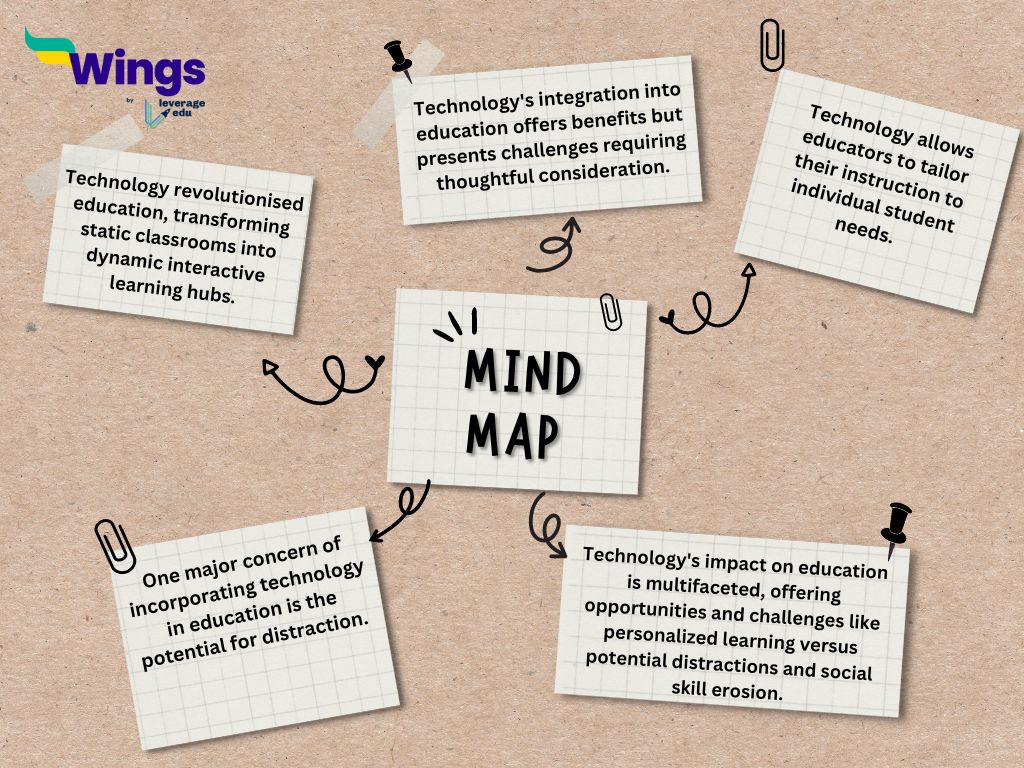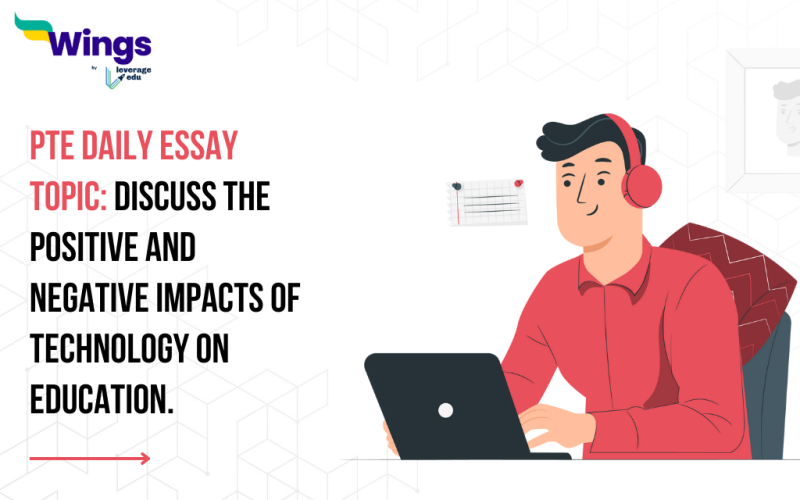Brainstorming Ideas
Refer to the following brainstorming ideas to get a solid understanding of the answer.
- Technology has undeniably revolutionised education, transforming classrooms from static environments into dynamic hubs of interactive learning.
- While technology offers a plethora of benefits, its integration into education also comes with challenges that require careful consideration.
- Technology allows educators to tailor their instruction to individual student needs.
- One major concern of incorporating technology in education is the potential for distraction.
- Technology’s impact on education is multifaceted. While it offers exciting opportunities for personalised and engaging learning, its potential for distraction and the erosion of social skills cannot be ignored.

Q. Discuss the positive and negative impacts of technology on education.
Ans. Technology has undeniably revolutionised education, transforming classrooms from static environments into dynamic hubs of interactive learning. This digital revolution, however, presents a double-edged sword. While technology offers a plethora of benefits, its integration into education also comes with challenges that require careful consideration.
On the positive side, technology empowers educators to create engaging and personalised learning experiences. Interactive whiteboards, educational apps, and virtual reality simulations can bring abstract concepts to life, fostering a deeper understanding in students. Imagine a history lesson where students can virtually walk the halls of ancient Rome or a biology class where they can dissect a virtual frog. These immersive experiences spark curiosity and ignite a passion for learning that traditional textbooks often struggle to achieve. Furthermore, technology allows educators to tailor their instruction to individual student needs. Adaptive learning platforms can identify knowledge gaps and recommend personalised learning pathways, ensuring each student progresses at their own pace. This caters to diverse learning styles and ensures no student gets left behind.
However, technology’s influence on education is not without its drawbacks. One major concern is the potential for distraction. With laptops and tablets readily available, the allure of social media, games, and other online activities can easily divert students’ attention from the task at hand. This constant digital stimulation can hinder focus and lead to a decline in critical thinking skills. Students accustomed to instant information from search engines may struggle with developing the research and analytical skills necessary for deeper learning. Additionally, the overreliance on technology can erode essential social skills. This is because students may lack participation in classroom activities, which often involve collaboration and communication—skills that are nurtured through face-to-face interaction. Excessive screen time can impede students’ ability to communicate effectively and build strong relationships with their peers.
In conclusion, technology’s impact on education is multifaceted. While it offers exciting opportunities for personalised and engaging learning, its potential for distraction and the erosion of social skills cannot be ignored. By embracing technology thoughtfully, we can create a learning environment that empowers students to thrive in the digital age.
Analysis
Paraphrased Statement: Technology has undeniably revolutionised education, transforming classrooms from static environments into dynamic hubs of interactive learning.
Thesis Statement: This digital revolution, however, presents a double-edged sword. While technology offers a plethora of benefits, its integration into education also comes with challenges that require careful consideration.
Body Paragraph 1– Topic Sentence: Technology empowers educators to create engaging and personalised learning experiences.
Body Paragraph 1 Supporting Reasons and Explanations: Interactive whiteboards, educational apps, and virtual reality simulations can bring abstract concepts to life, fostering a deeper understanding in students. These immersive experiences spark curiosity and ignite a passion for learning that traditional textbooks often struggle to achieve.
Body Paragraph 2- Topic Sentence: Technology’s influence on education is not without its drawbacks. One major concern is the potential for distraction.
Body Paragraph 2 Supporting Reasons and Explanations: With laptops and tablets readily available, the allure of social media, games, and other online activities can easily divert students’ attention from the task at hand. This constant digital stimulation can hinder focus and lead to a decline in critical thinking skills.
Conclusion: In conclusion, technology’s impact on education is multifaceted. While it offers exciting opportunities for personalised and engaging learning, its potential for distraction and the erosion of social skills cannot be ignored.
Vocabulary in Use
| Word | Meanings |
| Revolutionised | Transform |
| Static | Stagnant |
| Integration | Integration occurs when separate people or things are brought together |
| Adaptive learning | A technique that uses data-driven instruction to adjust and tailor learning experiences to meet the individual needs of each student. |
| Stimulation | An action or thing that causes someone or something to become more active or enthusiastic. |
| Collaboration | To work jointly with others or together in an intellectual endeavour. |
Are you preparing for the PTE Exam? Check out the blogs below to bolster your chances of securing better scores in the PTE exam.
Download the Leverage App today.


Need help preparing for PTE? Check out the best PTE preparation courses in the market offered in a live training environment by trusted educators. If you want to help studying abroad, call 1800572130.
 One app for all your study abroad needs
One app for all your study abroad needs















 60,000+ students trusted us with their dreams. Take the first step today!
60,000+ students trusted us with their dreams. Take the first step today!